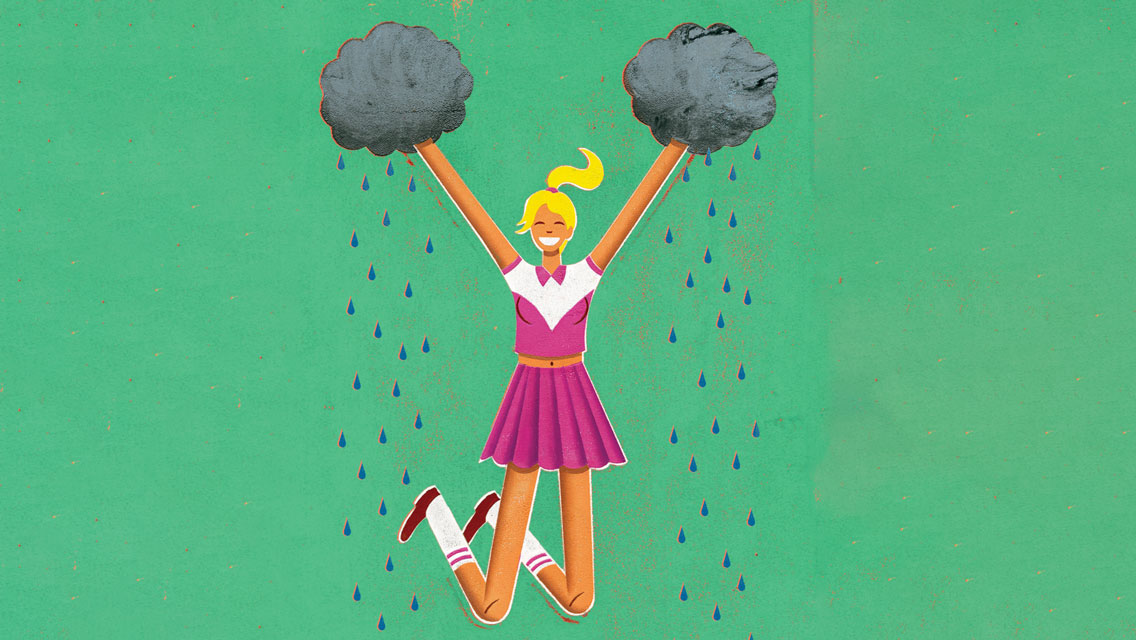As a veteran journalist covering psychology and personal development, Oliver Burkeman has encountered most of the strategies for being happy. He’s also seen a lot of them fall short. “For a civilization so fixated on achieving happiness,” writes Burkeman in his best-selling new book, The Antidote: Happiness for People Who Can’t Stand Positive Thinking, “we seem remarkably incompetent at the task.”
Research shows, for example, that self-help books rarely improve our collective mood and that a thriving “happiness industry” — replete with self-help books, well-known motivational speakers and celebrity psychologists — does not correlate with a statistical increase in satisfaction. Even money doesn’t boost mood above a certain basic level.
Burkeman began to ask what, if anything, increases happiness? Are there strategies for finding bliss — or are we doomed to a particular mood?
Luckily, we’re not trapped. What Burkeman unearthed was a counterintuitive route to building more joy in our lives. His theory, that there is a “negative path to happiness,” is based on the idea that the less we strive for jubilation, the more of it we experience. The Antidote is an examination of this paradox.
The Negative Path to Happiness
It’s fair to question Burkeman’s thesis right off the bat: If striving for happiness makes us less so, are we destined to be permanently morose? The simple answer is no. The negative path to happiness isn’t a rejection of positivity; it’s a route to finding joy by not searching for it so tenaciously. “The effort to try to feel happy is often precisely the thing that makes us miserable,” Burkeman writes. “It is our constant efforts to eliminate the negative — insecurity, uncertainty, failure or sadness — that is what causes us to feel so insecure, anxious, uncertain or unhappy.”
It’s important not to confuse the negative path with contrarianism or cynicism. “You don’t do yourself any favors by walking into the path of oncoming buses,” Burkeman explains. Nor should it be taken “as implying that there’s necessarily anything wrong with optimism. A more useful way to think of it is as a much-needed counterweight to a culture fixated on the notion that optimism and positivity are the only possible paths to happiness.”
The negative path is a middle road. It’s about rejecting the dichotomy between permanent gloominess and perfect joy, and accepting that genuine happiness arises through embracing all of life’s experiences as they come, “rather than trying to drown negativity out with relentless good cheer.”
One of the most effective, time-tested ways to accomplish this come-what-may state of mind is to cultivate an attitude of nonattachment — and one of the best methods for doing that is to practice meditation.
The Art of Letting Go
There’s a modern-day tendency to think of meditation “as a sophisticated form of positive thinking, which is almost the opposite of the truth,” Burkeman says. “In fact, meditation has little to do with achieving any specific, desired state of mind, no matter whether blissful or calm.” Instead, the ancient practice is about learning to detach from our desires to do, fix or pursue things, whether good or bad.
“Rather than merely enjoying pleasurable things during the moments in which they occur — and experiencing the unpleasantness of painful things [in the same way] — we develop the habits of clinging and aversion,” Burkeman writes. “We grasp at what we like, trying to hold on to it forever, and push away what we don’t like, trying to avoid it at all costs. Both constitute attachment.
“Develop a strong attachment to your good looks — as opposed to merely enjoying them while they last — and you will suffer when they fade, as they inevitably will; develop a strong attachment to your luxurious lifestyle, and your life may become an unhappy, fearful struggle to keep things that way.”
The more we’re able to engage in the non-attached observation fostered by meditation, even for just a few minutes a day, the calmer and less reactive we feel. (For beginning instruction on how to meditate, see “The Strength to Sit Still.”
Rethinking Goals
Setting goals can play an important role in moving our lives forward and helping us reach our aspirations — a prospect we associate, often rightly, with positive feelings. When we over-identify with our goals, however, we can set ourselves up for frustration.
The Antidote examines the work of Christopher Kayes, an associate professor of management at George Washington University in Washington, D.C., who studies how the overly intense pursuit of a specific objective can become problematic. He often cites the example of a failed expedition to Mount Everest to make his point.
In 1996 a group of experienced climbers, led by an accomplished Sherpa, set out on a sunny day to summit Mount Everest. All the climbers knew the most important rule for a safe trip: Do not continue to ascend the peak past 2 p.m., no matter where you are on the mountain, or you risk an unsafe descent.
The group, however, climbed all the way until 4 p.m., as night fell and the weather turned dangerous. Most of the climbers died.
How could an experienced group of adventurers make this mistake? Kayes’s hypothesis is that “the more they fixated on the endpoint — a successful summiting of the mountain — the more that goal became not just an external target but a part of their own identities, of their sense of themselves as accomplished guides or high-achieving amateurs.”
Not all life goals carry the same risks and emotional charge, of course, but every target we set for ourselves can come with its own small version of “summit fever” — and we can become so engrossed in pursuing our objectives that we stop seeing them as separate from ourselves. Before long, our self-esteem depends on our success, the very possibility of failure causes intense distress, and we go to exhausting, unhappiness-promoting lengths to reach the finish line.
On the negative path to happiness, the aim is to see aspirations as positive and necessary for forward movement. But these exterior plans should not define our interior lives or determine our outlook or identity. The negative path reminds us that we are not what we achieve.
In the end, says Burkeman, the negative path isn’t about giving up our quest for a more joyful life; it’s about changing the way we go about it. When we take a few counter-intuitive turns on the road to happiness, we’re more apt to successfully arrive at our destination.
This originally appeared as “The Antidote.”




This Post Has 0 Comments